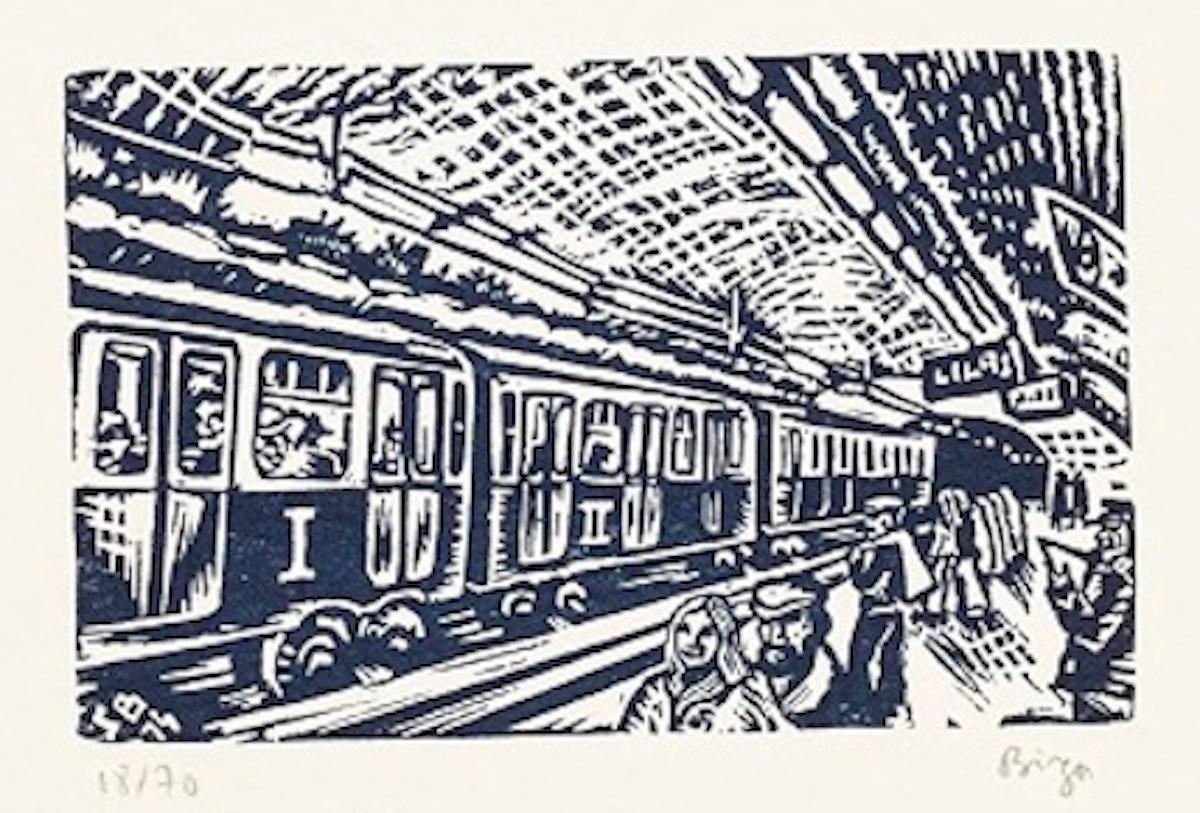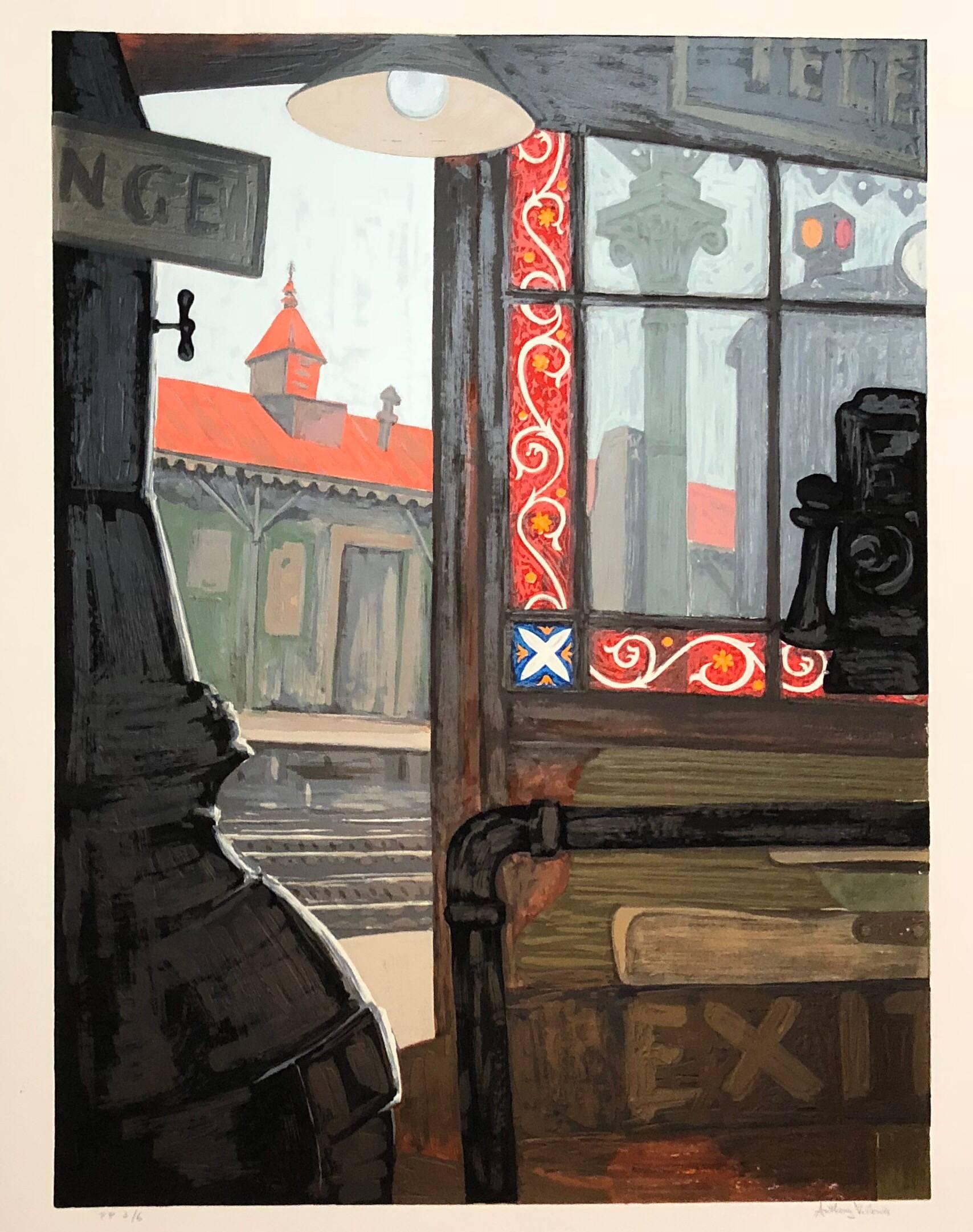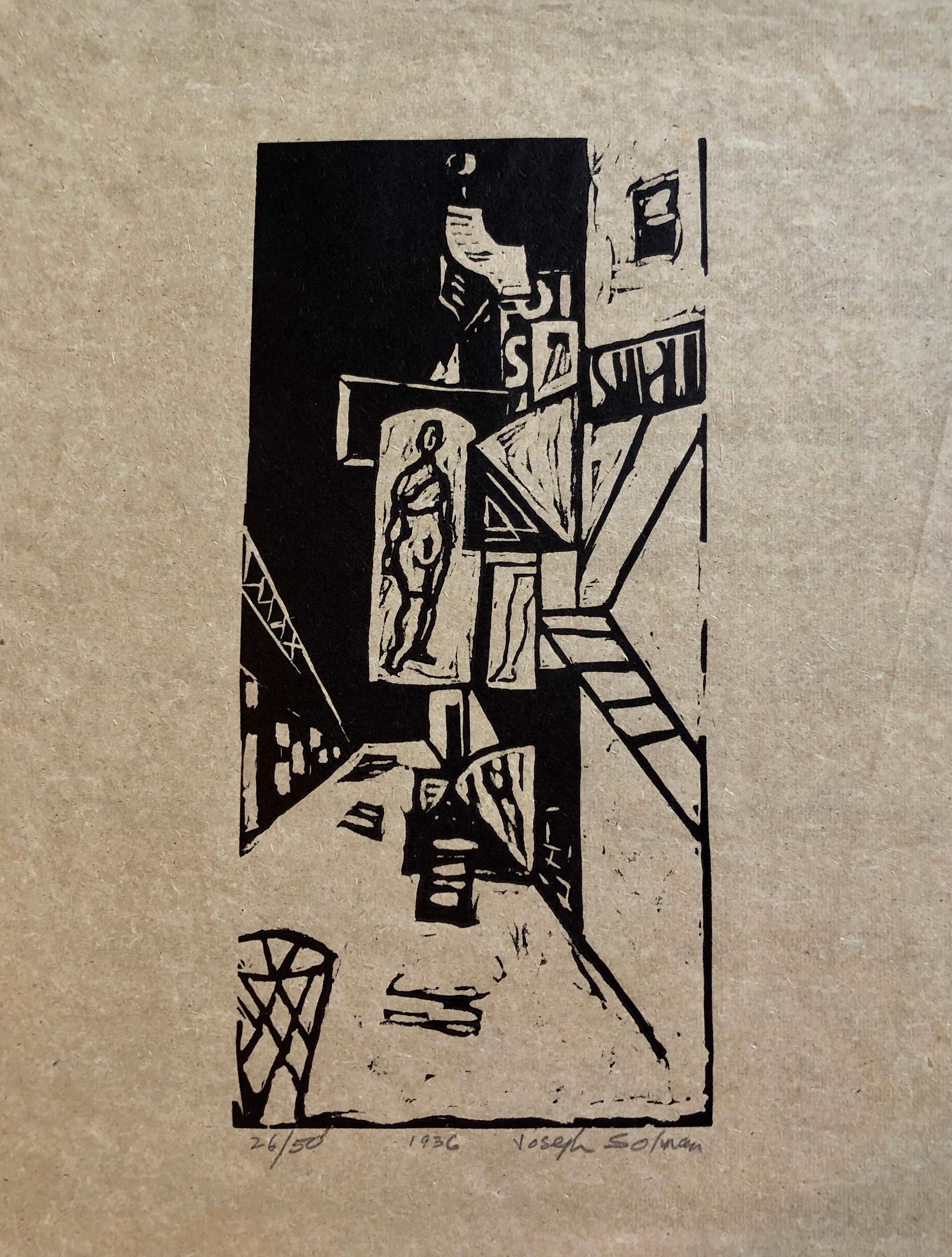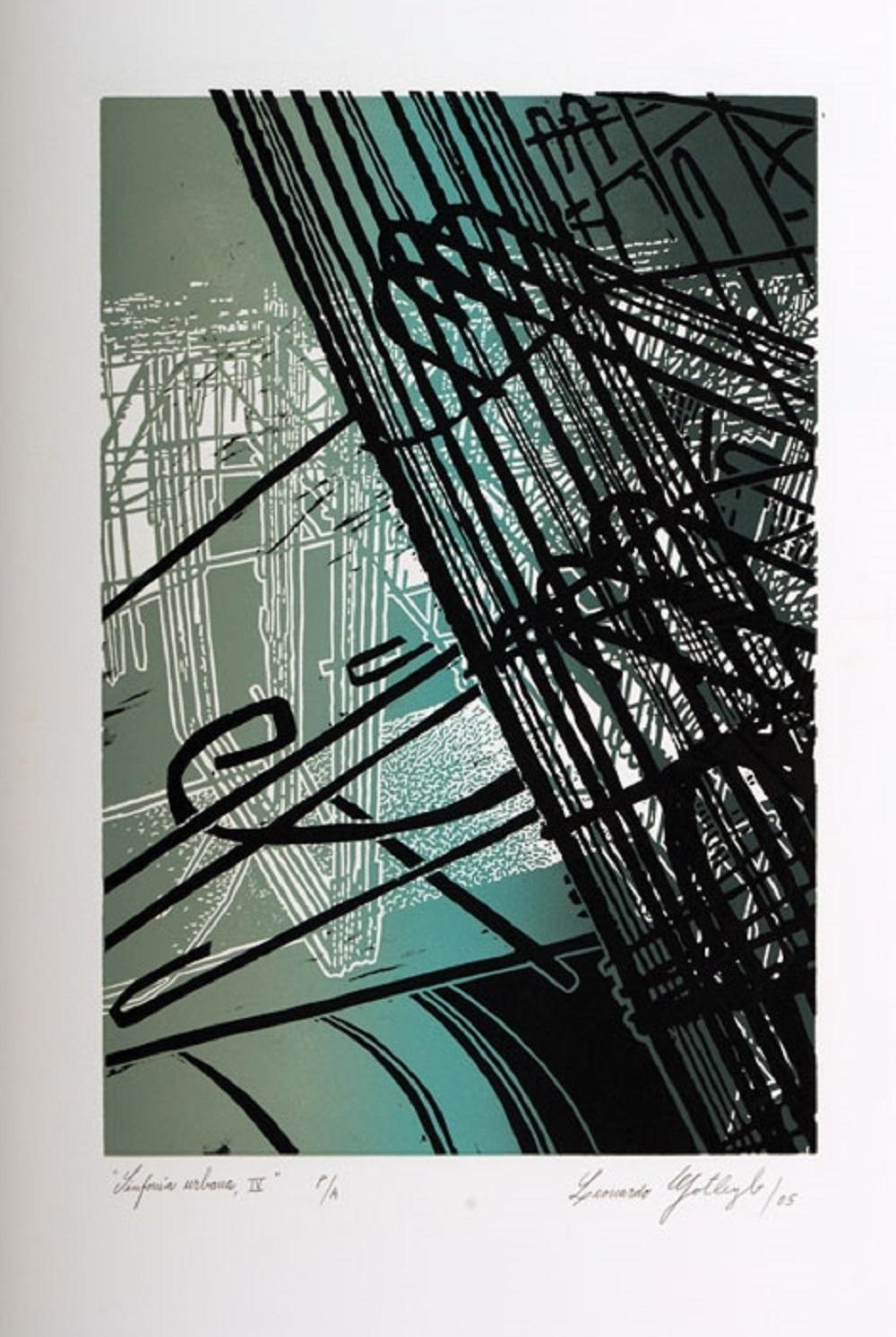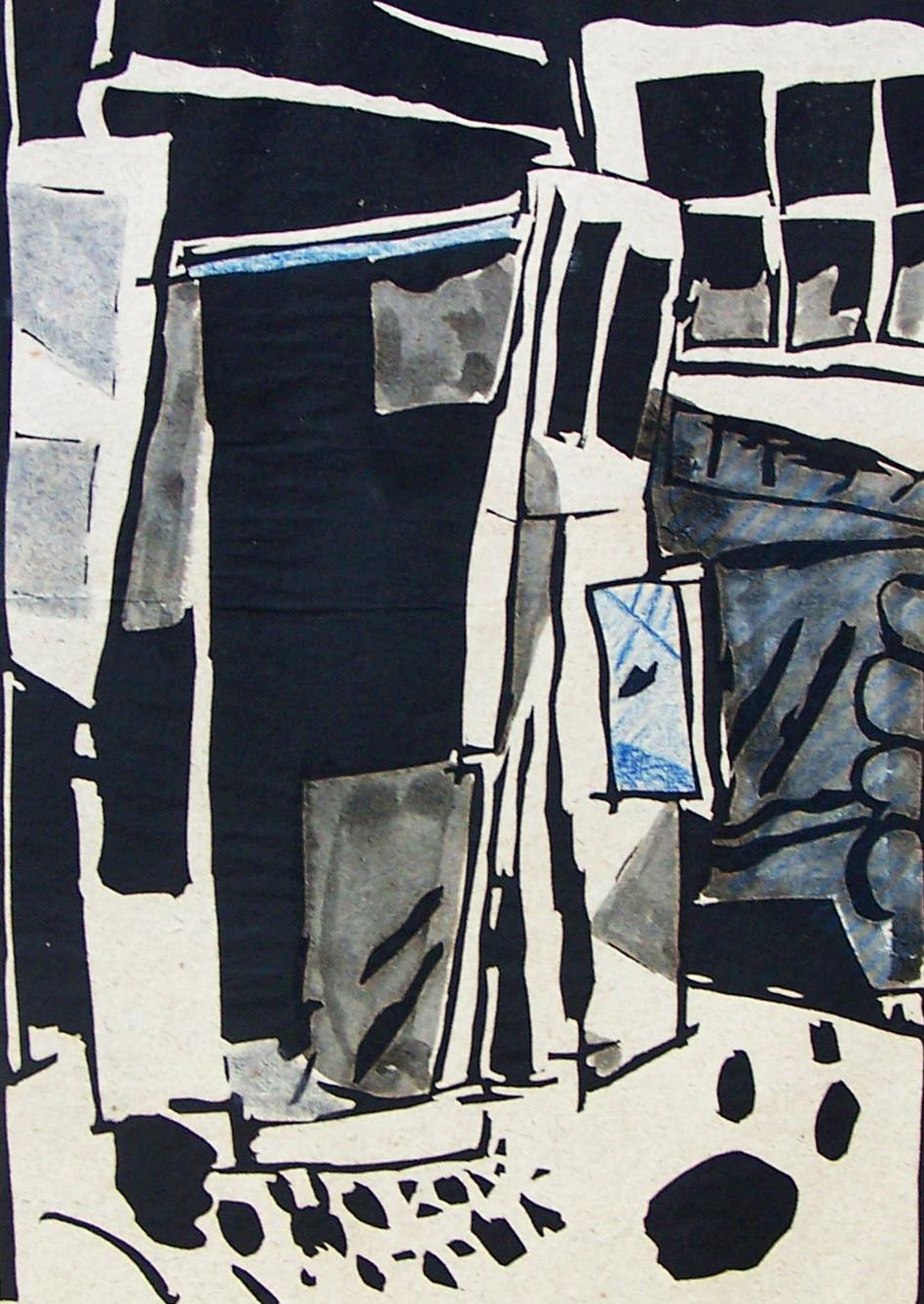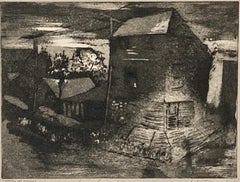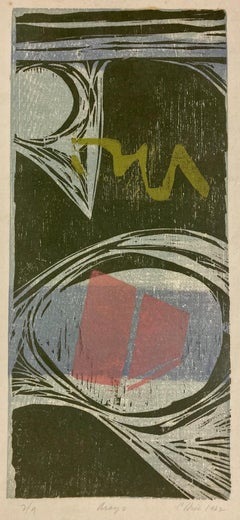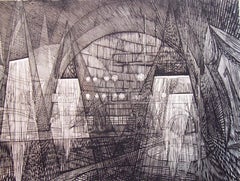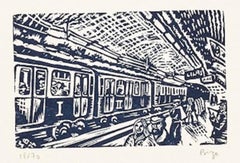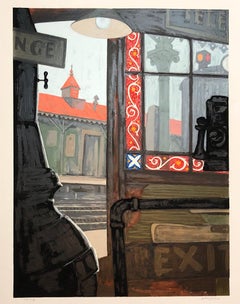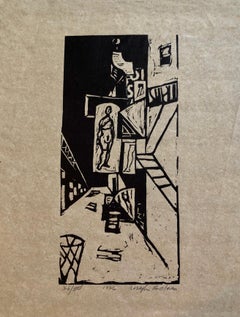Items Similar to Ted Davies, El Station (New York City), woodcut
Want more images or videos?
Request additional images or videos from the seller
1 of 9
Ted DaviesTed Davies, El Station (New York City), woodcut1957
1957
$960
$1,20020% Off
£734.23
£917.7920% Off
€840.26
€1,050.3220% Off
CA$1,366.34
CA$1,707.9320% Off
A$1,479.35
A$1,849.1920% Off
CHF 786.50
CHF 983.1320% Off
MX$17,842
MX$22,302.5020% Off
NOK 9,890.72
NOK 12,363.4020% Off
SEK 9,220.97
SEK 11,526.2120% Off
DKK 6,275.64
DKK 7,844.5520% Off
About the Item
In the 1950s woodcuts were getting bigger and bigger. This one isn't gigantic, but at an image size of 17 x 11 inches it is substantial. And of course NYC's El Trains and their stations are a hugely popular topic. Here Davies shows us an elevated station of New York City's (largely) subway system. He includes the neo-classical dome that many stations still have as well as the dizzying patterns of stairs, tracks, and platforms.
Printed mostly in black ink, there are small areas of brown that enrich the surface. It is numbered over 100 but this should be considered a proposed edition size. It is highly unlikely there were ever more than 20 or 30 impressions.
It is signed, titled, dated, and numbered, in pencil.
- Creator:Ted Davies (1928, American)
- Creation Year:1957
- Dimensions:Height: 17.5 in (44.45 cm)Width: 11.5 in (29.21 cm)
- Medium:
- Movement & Style:
- Period:
- Condition:The sheet is in fine shape. There are small, inconspicuous spots in the upper left quarter. A shot of the reverse is included to confirm good condition of the entire sheet.
- Gallery Location:New York, NY
- Reference Number:1stDibs: LU141027702542
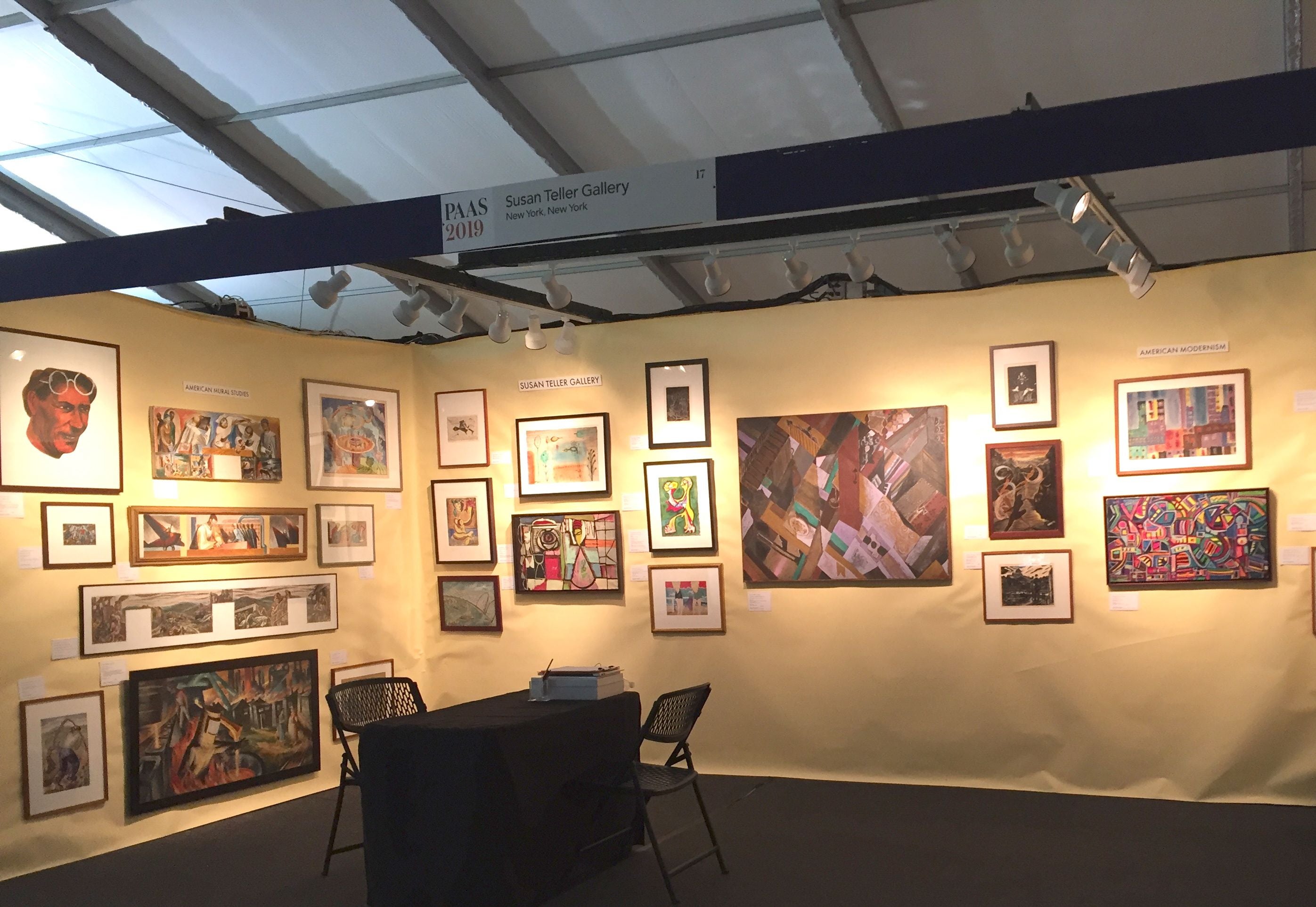
About the Seller
4.9
Gold Seller
Premium sellers maintaining a 4.3+ rating and 24-hour response times
Established in 1988
1stDibs seller since 2020
129 sales on 1stDibs
Typical response time: 5 hours
- ShippingRetrieving quote...Shipping from: New York, NY
- Return Policy
More From This Seller
View AllTed Witonski, NYC (Chelsea) skyline intaglio
Located in New York, NY
An Ohio native Witonski made his home in the Chelsea neighborhood of New York City and this subject may well be a Chelsea scene. But mostly it is a homage to intaglio printmaking. It...
Category
1930s American Modern Landscape Prints
Materials
Intaglio
Clinton Hill, Arroyo, 1962, woodcut, landscape/abstraction
By Clinton Hill
Located in New York, NY
Clinton Hill (1922-2003), lived in SoHo, New York, and was a frequent Gallery visitor. Born in Idaho and raised on a working ranch, he joined the US Navy during World War II and beca...
Category
Mid-20th Century Abstract Landscape Prints
Materials
Woodcut
Armin Landeck, Paris Metro
By Armin Landeck
Located in New York, NY
The reference number on this work is Kraeft 114 i/ii.
As this is an impression of the first state it was printed in an edition of 30. There was a second state, made in 1971, for whi...
Category
Mid-20th Century American Modern Prints and Multiples
Materials
Engraving
Werner Drewes, 125th Street at Broadway, NYC
By Werner Drewes
Located in New York, NY
Werner Drewes brought his modernist vision to this subject but created, in my opinion, a great work of the Etching Revival.
The reference is Rose 183. It...
Category
1930s American Modern Landscape Prints
Materials
Drypoint
Kevin B. O'Callahan, (Street Scene) (Buffalo, NY?)
By Kevin B. O'Callahan
Located in New York, NY
This (Street Scene) is undoubtedly O'Callahan's hometown of Buffalo, NY, where he lived and spent most of his career. The artist's name appears in pencil at the bottom edge on the re...
Category
1930s Aesthetic Movement Landscape Prints
Materials
Intaglio
Leonard Pytlak, (Industrial Landscape, New York City)
By Leonard Pytlak
Located in New York, NY
This lithograph is signed and number in pencil. It is numbered 18/18 indicating there were 18 impressions of this subject printed.
Category
1930s Ashcan School Landscape Prints
Materials
Lithograph
You May Also Like
The Metro Station in Paris - Original Woodcut by S. Birga - 1994
Located in Roma, IT
The Metro Station in Paris is an original contemporary artwork realized by Sergio Birga (Florence, 1940) in 1994.
Original B/W xylograph on ivory paper. Pa...
Category
1990s Modern Interior Prints
Materials
Woodcut
Modernist Silkscreen Screenprint 'El Station, Interior' NYC Subway, WPA Artist
By Anthony Velonis
Located in Surfside, FL
screenprint printed in color ink on wove paper. New York City subway station interior.
Anthony Velonis (1911 – 1997) was an American painter and designer born in New York City who helped introduce the public to silkscreen printing in the early 20th century.
While employed under the federal Works Progress Administration, WPA during the Great Depression, Velonis brought the use of silkscreen printing as a fine art form, referred to as the "serigraph," into the mainstream. By his own request, he was not publicly credited for coining the term.
He experimented and mastered techniques to print on a wide variety of materials, such as glass, plastics, and metal, thereby expanding the field. In the mid to late 20th century, the silkscreen technique became popular among other artists such as Robert Rauschenberg and Andy Warhol.
Velonis was born into a relatively poor background of a Greek immigrant family and grew up in the tenements of New York City. Early on, he took creative inspiration from figures in his life such as his grandfather, an immigrant from the mountains in Greece, who was "an ecclesiastical painter, on Byzantine style." Velonis attended James Monroe High School in The Bronx, where he took on minor artistic roles such as the illustration of his high school yearbook. He eventually received a scholarship to the NYU College of Fine Arts, into which he was both surprised and ecstatic to have been admitted. Around this time he took to painting, watercolor, and sculpture, as well as various other art forms, hoping to find a niche that fit. He attended NYU until 1929, when the Great Depression started in the United States after the stock market crash.
Around the year 1932, Velonis became interested in silk screen, together with fellow artist Fritz Brosius, and decided to investigate the practice. Working in his brother's sign shop, Velonis was able to master the silkscreen process. He reminisced in an interview three decades later that doing so was "plenty of fun," and that a lot of technology can be discovered through hard work, more so if it is worked on "little by little."
Velonis was hired by Mayor LaGuardia in 1934 to promote the work of New York's city government via posters publicizing city projects. One such project required him to go on a commercial fishing trip to locations including New Bedford and Nantucket for a fortnight, where he primarily took photographs and notes, and made sketches. Afterward, for a period of roughly six months, he was occupied with creating paintings from these records. During this trip, Velonis developed true respect and affinity for the fishermen with whom he traveled, "the relatively uneducated person," in his words.
Following this, Velonis began work with the Public Works of Art Project (PWAP), an offshoot of the Civil Works Administration (CWA), where he was assigned to serve the different city departments of New York. After the formation of the federal Works Progress Administration, which hired artists and sponsored projects in the arts, he also worked in theater.
Velonis began working for the federal WPA in 1935. He kept this position until 1936 or 1938, at which point he began working in the graphic art division of the Federal Art Project, which he ultimately led. Under various elements of the WPA program, many young artists, writers and actors gained employment that helped them survive during the Depression, as well as contributing works that created an artistic legacy for the country.
When interviewed in December 1994 by the Library of Congress about his time in the WPA, Velonis reflected that he had greatly enjoyed that period, saying that he liked the "excitement" and "meeting all the other artists with different points of view." He also said in a later interview that "the contact and the dialogue with all those artists and the work that took place was just invaluable." Among the young artists he hired was Edmond Casarella, who later developed an innovative technique using layered cardboard for woodcuts.
Velonis introduced silkscreen printing to the Poster Division of the WPA. As he recalled in a 1965 interview: "I suggested that the Poster division would be a lot more productive and useful if they had an auxiliary screen printing project that worked along with them. And apparently this was very favorably received..."
As a member of the Federal Art Project, a subdivision of the WPA, Velonis later approached the Public Use of Arts Committee (PUAC) for help in "propagandizing for art in the parks, in the subways, et cetera." Since the Federal Art Project could not be "self-promoting," an outside organization was required to advertise their art more extensively. During his employment with the Federal Art Project, Velonis created nine silkscreen posters for the federal government.
Around 1937-1939 Velonis wrote a pamphlet titled "Technical Problems of the Artist: Technique of the Silkscreen Process," which was distributed to art centers run by the WPA around the country. It was considered very influential in encouraging artists to try this relatively inexpensive technique and stimulated printmaking across the country.
In 1939, Velonis founded the Creative Printmakers Group, along with three others, including Hyman Warsager. They printed both their own works and those of other artists in their facility. This was considered the most important silkscreen shop of the period.
The next year, Velonis founded the National Serigraph Society. It started out with relatively small commercial projects, such as "rather fancy" Christmas cards that were sold to many of the upscale Fifth Avenue shops...
Category
1980s American Modern Figurative Prints
Materials
Screen
Charles Keller Original Stone Lithograph - "6th Avenue Subway”
Located in Phoenix, AZ
Original lithograph by Charles Keller depicting the subway being built in New York
on 6th Avenue in 1937. This print is inscribed lower left: “To W.B.”
The print is in excellent con...
Category
Mid-20th Century More Prints
Materials
Lithograph
1936 Woodblock Print Venus of 23rd St. Skid Row Woodcut NYC Great Depression WPA
By Joseph Solman
Located in Surfside, FL
A great New york City street scene in a modernist realist style. done in the the great depression period.
Mat is 17.5x14, sheet measures 13x10 image is 10x4.75
Joseph Solman (Janua...
Category
20th Century Modern More Art
Materials
Woodcut
Leonardo Gotleyb, ¨Sinfonia urbana IV¨, 2005, Woodcut, 29.9x22 in
Located in Miami, FL
Leonardo Gotleyb (Argentina, 1958)
'Sinfonia urbana IV', 2005
woodcut on paper Rives BFK 300 g.
30 x 22.1 in. (76 x 56 cm.)
ID: GOT-310
Hand-signed by author
Category
Early 2000s Contemporary Prints and Multiples
Materials
Paper, Screen, Woodcut
Portfolio L'Atelier - 10 Linocuts Russian
By Jean Pougny
Located in London, GB
The portfolio consists of 10 linocuts, each printed on a separate sheet and stamp signed with the artist's signature stamp "Pougny".
These original prints were created by Pougny hims...
Category
1910s Interior Prints
Materials
Linocut, Stencil
More Ways To Browse
Le Blanc Seing
Leger Hand Signed Lithograph
Leonard H Mersky
Leroy Neiman Americas Cup
Leroy Neiman Silkscreens
Leroy Neiman Skier
Leroy Neiman Stud Poker
Leroy Neiman Vegas
Lichtenstein Crak
Lichtenstein Mermaid
Lord Leighton Photogravure
Luigi Rossini On Sale
Magritte Victoire
Malcolm Myers
Malleus Maleficarum
Marc Chagall Blue Bird
Marc Chagall Couverture
Marc Chagall Diptych
